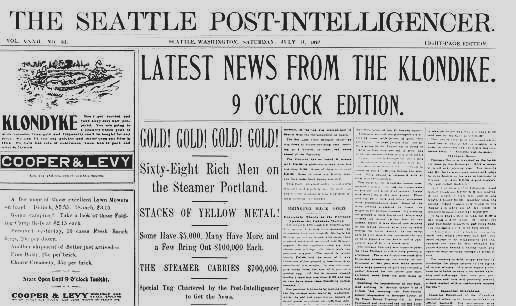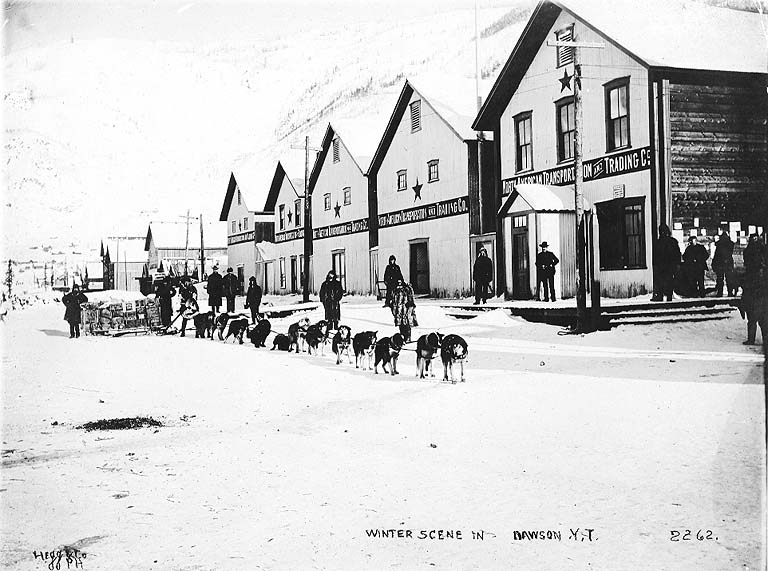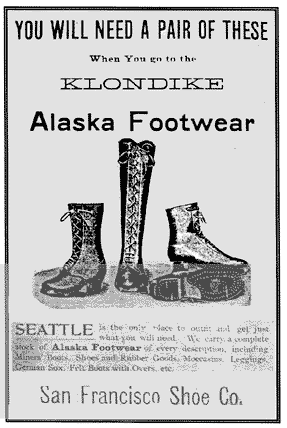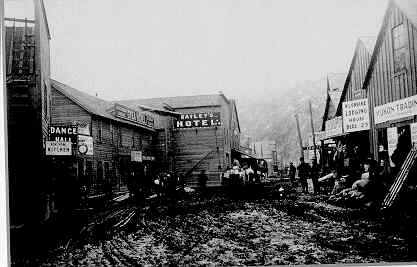Webquest for
The Call of the Wild
Diary of an Adventure.
Can you survive and prosper, or will the Yukon claim
another dreamer?
Introduction
In August 1896, Skookum Jim Mason, Dawson Charlie
and George Washington Carmack found gold in a tributary of the Klondike
River in Canada's Yukon Territory. Their discovery set off one of the greatest
gold rushes in history.
All kinds of men (and women too), sold or gave up everything
they had, and tried to strike it rich. A few actually did (mostly the early
arrivals), some decided to profit from the gold fever of others. Some had
to move back to wherever they came from, broke and broken, and many didn't
make it at all. The Canadian Mounties (their organization began during
this tumultuous time) tried to keep order, but there were scams and hoodlums
and all kinds of unsavory characters. You had to watch your back, as well
as the weather.
Jack London wrote vividly about life during that time,
and the effects the harsh environment and circumstances had on the men
and animals who lived through it. Now it's your turn.
(Pic from: University
of Washington Libraries)
 Task
Task
Before reading the novel Call of the Wild, by
Jack London, you will create a character from the Yukon gold rush, and
research what his/her experience might have been like. You will create
a diary with images of your experience (this can take many forms including
a scrapbook, a Power Point presentation, or a web page), and predict where
your character might be in three years.
By the end, you should have a good understanding
and knowledge of the historical/cultural context of the Yukon gold rush.
You should be able to use information you find on the 'net to formulate
knowledgeable, supportable opinions of what your character's chances would
have been, what hardships he/she might have faced, and what their reasons
for being there were. You will work together with the members of your team
to decide what information to use and how to present it.
(Pic from: Klondike
Gold Rush National Historic Park)
Process
The class will be divided into groups of four. Each group
will be nominally based in Dyea, Skagway, or Dawson. Before you decide
who's who, do some group research about the time (1898) and place.
Then decide which role each person will research and create
a journal for:
Dawson Group:
Canadian Mountie
Dawson Merchant
Scam Artist in Dawson
Dogsled Mail Carrier |
Skagway Group:
Male stampeder
Female Stampeder
Skagway Merchant
Sled Dog |
Dyea Group:
Male Stampeder
Female Stampeder
Dyea Merchant
Sled Dog |

Use the links in the Resources section to research and
create a character.
You should also use the suggested keywords to search
for more links.
To begin with, create a "sketch" of your character:
-
A name and a Klondike nickname.
-
A physical description. (150+ words)
-
A hometown and brief biography up to the decision to leave
for the Yukon. (150+ words)
-
An explanation of why he/she is here.
The pre-research and the choosing of characters and names
should be done collaboratively. You may either create a realistic fictional
character, use a real person you find in your research.
As you research, take notes about the experiences you
would have had, and the hardships you would have faced. Were you prepared?
What was the day-to-day experience like? What kinds of people did you deal
with? What equipment did you need? Were you able to get it? What problems
did you have? Was it what you expected? Did you succeed? Did you survive?
Your job will be to create a journal of your character's
experience. It should include:
-
At least 5 150+ word entries, covering a representative period
of time during the rush. (Remember, it was over quickly, and even more
quickly for most, so don't space your entries too far.)
-
At least two appropriate graphics or maps, appropriately
cited per entry. You can get your graphics from the sites you visit, or
use image search engines to find what you need. Be sure they match the
content of the journal, and are integral to it. Clip art, and images that
do not add meaning will not be counted.
-
At least three actual (appropriate) quotes from your research
sources.
-
An Epilogue that explains where your character is in 1900,
and what he/she is doing.
-
A list of which sites you used for your information and your
images.
Your group should collaborate on the eventual fates of
your group's characters. What seems most plausible, and in keeping with
history?
Your journals may take almost any form, including a scrapbook,
Power Point, or web page. Presentation and mechanics both count, as well
as content. Extra credit for especially authentic presentations. Your group
will present your journals together.
(Pic from: University
of Washington Libraries)
Resources
Remember; it will be up to you and your group to keep
track of the titles and URLs of the sites you use for your information
and images.
General Resources for all Characters and Background.
-
Brief
Overview from the Klondike Gold Rush National Historic Park. Also be
sure to follow the link for a year's worth of gear.
-
A
wealth of background info from the same place.
-
Stories
from the Gold Rush from the Smithsonian Postal Museum. A good place
to help you decide on a (human) character. Make sure you follow all the
links appropriate to your character.
-
The
Perilous Journey North from University of Washington Special Collections.
A great source for pics and background info on the experiences your character
would face.
-
Gold
Rush Stories from the Alaskan State Library. Short "stories" that are
good for making your character come to life. Be sure to check out all the
links.
Resources for Specific Characters.
Search Strings You Might Try to Find More Resources.
Of course, as you research, you'll come up with more.
-
yukon gold rush prospector survival
-
dogsled mail
-
yukon gold rush economy
-
yukon gold rush settler
-
yukon gold rush women
-
yukon gold rush dogs
-
yukon gold rush children
-
dawson history gold rush
-
dyea history
-
skagway history
-
rcmp yukon gold rush
Evaluation (200
points)
Scoring for Character Sketch (50)
-
Completeness
-
name and nickname (2)
-
150 word physical description (10)
-
150 bio/background (10)
-
reason for being here (3)
-
Mechanics (10)
-
Authenticity (5)
-
Style (5)
-
Documentation (5)
-
Bonus of up to 10% for above and beyond.
Scoring for Journal (150)
-
Completeness
-
5 entries @ 150 words each (50)
-
2 graphics per entry (20)
-
3 quotes from research (10)
-
epilogue (5)
-
Mechanics (20)
-
Authenticity/Evidence of Research (25)
-
Style/Presentation (15)
-
Documentation (5)
-
Bonus of up to 10% for above and beyond.
(Pic from: Klondike
Gold Rush National Historic Park.)
 Conclusion
Conclusion
Now you and your group will present your journals to
the class.
Please be prepared to take questions about your character
and your research.
Bonus credit for appearing in costume or answering
questions in character.
Now that you are fairly knowledgeable about the life
and times of people during the Yukon gold rush, we can compare our perceptions
with Jack London's descriptions. Is he realistic? Is he over-sensationalising?
Is The Call of the Wild true to the time?
Let's find out.
(Pic of street in Dyea from: The
Smithsonian Postal Museum.)
Teacher Page
Grade Level:
This webquest is intended for middle school students.
(Our district reads The Call of the Wild in eighth grade.)
Materials/Time Needed:
At least one computer with an internet connection for
every 4-5 students. Ideally this would take place in a computer lab, over
the course of about a week. The students will also need access to word
processing, and imaging software. (Freeware includes OpenOffice as a substitute
for MS Office and PhotoFiltre as a substitute for Photoshop.) Those that
choose to present a Power Point type journal would need the appropriate
software (OpenOffice has a Power Point equivalent), and the same goes for
those that choose to present web pages (SeaMonkey from Mozilla has a WYSIWYG
editor built in.) Students will also need a printer.
Standards Addressed (California - Grade 8 English-Language
Arts):
-
Reading - 2.6 Use information from a variety of consumer,
workplace, and public documents to explain a situation or decision and
to solve a problem.
-
Writing Organization and Focus - 1.1 Create compositions
that establish a controlling impression, have a coherent thesis, and end
with a clear and well-supported conclusion. 1.2 Establish coherence
within and among paragraphs through effective transitions, parallel structures,
and similar writing techniques.
-
Writing Research and Technology - 1.4 Plan and conduct multiple-step
information searches by using computer networks and modems. 1.5 Achieve
an effective balance between researched information and original ideas.
-
Writing Evaluation and Revision - 1.6 Revise
writing for word choice; appropriate organization; consistent point of
view; and transitions between paragraphs, passages, and ideas.
-
Writing Applications (Genres and Their Characteristics) -
2.1 Write biographies, autobiographies, short stories, or narratives:
a. Relate a clear, coherent incident, event, or situation by using well-chosen
details. b. Reveal the significance of, or the writer's attitude
about, the subject. c. Employ narrative and descriptive strategies
(e.g., relevant dialogue, specific action, physical description, background
description, comparison or contrast of characters).
-
Written and Oral English Language Conventions Sentence Structure
- 1.1 Use correct and varied sentence types and sentence openings to present
a lively and effective personal style. Grammar - 1.4 Edit written
manuscripts to ensure that correct grammar is used. Punctuation and
Capitalization - 1.5 Use correct punctuation and capitalization.
Spelling - 1.6 Use correct spelling conventions.
Desired Student Outcomes:
-
Greater knowledge of the people and circumstances of the
Yukon gold rush, and its place in history.
-
Background knowledge for greater appreciation of the role
that the setting plays in The Call of the Wild.
-
Produce lively first person accounts, based on historical
facts.
-
Learn research, citation, and presentation skills.
-
Learn to work together collaboratively.
Assessment:
Use the scoring guides given.
Tips for Delivery:
The students should be able to follow the process fairly
independently. You might give some mini-lessons about narrowing your search
with quotes or using strings of words. I would also ephasize giving credit
for the information AND the graphics. I would allot about a week,
and then another day or two for presenting.
You should give the presentation a separate grade, and
perhaps use a panel of students to ask questions. This way, you address
even more standards, and the kids get to see each other's work. You probably
already have a presentation rubric for other projects.
After you do it once, I don't have to tell you to keep
samples for the next round. That also gives you an opportunity to tweak
it based on the results you get the first time. Please let me know if you
come up with any changes that might improve this quest.
The Author:
Mr. Coward teaches 7th grade English at Laguna Middle
School in San Luis Obispo, CA. He has been teaching for 17 years.
For more resources, please visit: SeventhGradeEnglish.com.
E-mail: mcoward@slcusd.org.
Credits:
All images taken from the site listed in the Resources
section, and credited where they are used.
Credit goes to Bernie Dodge for creating the first webquest,
and defining the main ideas and rubrics.
Thanks to George Smith for the WebQuest class which this
quest is a result of.
Permission is granted for others to use and modify this
webquest, as long as credit is given, and the use is not for profit.x

 Task
Task


 Conclusion
Conclusion